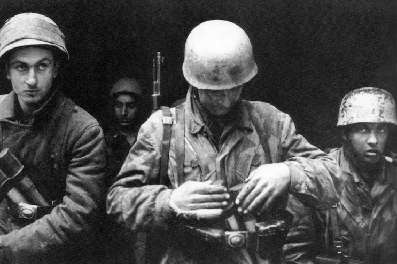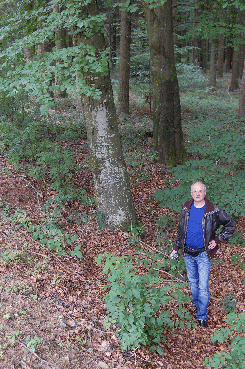Background: On 16 December 1944 Operation 'Herbstnebel,' the German Ardennes Offensive, was launched. The Americans were caught totaslly by surprise, and their front lines collapsed. While the armored spearheads of the 6. SS-Panzerarmee and the 5. Panzerarmee surged westwards, smashing any resistance offered by the Americans, the German southern flank was covered by the 7. Armee. In this army, Oberst (colonel) Ludwig Heilmann's 5. Paratroop Division constituted the most powerful force. On 19 December, Heilmann's paratroopers have advanced twelve miles across previously U.S.-controlled territory in northern Luxembourg, and they have surrounded the town of Wiltz, six miles outheast of Bastogne. Just before the pincers closed around Wiltz, the remnants of an American battalion which previously had waged brave fight against the 5. Panzerarmee farther to the north, managed to break out and retreat towards the south. But at the road junction Schumann's Eck an unpleasant surprise waits for the Americans. It is dark and cold as the American vehicle column approaches the road junction with the famous café. Excerpt from The Ardennes 1944-1945: Hitlers Winter Offensive, from Chapter Five: 7. Armee – Secure the flank! German paratroopers in the Ardennes in December 1944.
While the American artillerymen took refuge in the neighboring Café Schumann, a whole column of U.S. combat vehicles suddenly appeared with their headlamps on. These carried two hundred men of Major Harold F. Milton’s 3rd Battalion, 110th Regimental Combat Team. This was the remains of the gallant battalion that by clinging on to Hosingen and Consthum had delayed Panzer Lehr Division's advance by almost two days. After this epic battle they withdrew to Wiltz, and managed to get out of there before this town was surrounded, and now they came along the road to Bastogne--without having a clue that the Germans had reached that far west.
Café Schumann todayn. Photo: The author. The engines screamed as the heavy lorries slowly worked their way up the icy hill on the lowest gear, towards the crossroads. Leutnant Sander’s stunned men paused for a moment, but then a Panzerfaust put a half-track vehicle in flames, and another knocked out a tank farther back in the column. Major Milton's men hastily abandoned their vehicles and hurled themselves headlong right into the darkness. They tumbled down the slope into the beech forest, and before they got to their feet, they had been overpowered by the paratroopers and surrendered.
According to Horst Lange, one of the participating German paratroopers, the Americans lost between six and eight tanks during this firefight. Meanwhile, the artillerymen in Café Schumann were under great pressure. One of them, Sergeant Gene Fleury, remembershow the brazen paratroopers yelled at them from the darkness outside: 'No more zig-zig [sex] in Paris!' The American artillerymen decided to surrender, and shivering with fear they went out through the front door where they were apprehended by the Fallschirmjäger, who were characterized by Private First Class Ervin McFarland as ’wild and very young, no doubt teenagers.’ Sergeant Austin remembers: ’They slapped and banged you around, stripped you down, took your watch, took your wallet, pen knives, and even made me take off my shoes.’ Then the small group of paratrooper brought their several hundred prisoners and a large number of captured vehicles and artillery to the east. Two months later, Leutnant Sander was awarded with the Knight's Cross.
* Regimental Combat Team was a U.S. infantry regiment reinforced with e.g. armor.
German propaganda film showing paratroopers versus U.S. armor in France in 1944
Order your English copy here now!
Click here to return to the front page on the Ardennes 1944-1945 - Hitler's Winter Offensive
|


